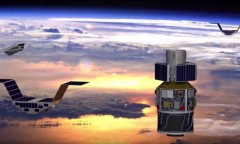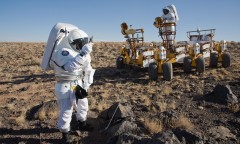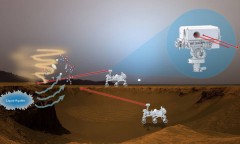By Vishal Goel, | November 21, 2016

A United Launch Alliance (ULA) Atlas V rocket carrying GOES-R, the most advanced weather satellite, for NASA and NOAA. (YouTube)
NASA launched the most advanced weather satellite ever built into space on Saturday. This new GOES-R spacecraft will track the US weather including hurricanes, flooding, tornadoes, volcanic ash clouds, wildfires, lightning storms, and even solar flares.
This new mission is aimed at getting much more data, more often, that would be detailed and at a higher resolution.
Like Us on Facebook
The satellite was launched from Launch Complex 41 at Cape Canaveral Air Force Station on a ULA Atlas V rocket at 6:42 p.m. EST, according to NASA. About 50 TV meteorologists from all over the country arrived to witness the launch, along with around 8,000 space program workers and guests, Phys reported.
"The launch of GOES-R represents a major step forward in terms of our ability to provide more timely and accurate information that is critical for life-saving weather forecasts and warnings," said Thomas Zurbuchen, associate administrator for NASA's Science Mission Directorate in Washington.
This mission is an example of the decades-long partnership between NASA and NOAA (National Oceanic and Atmospheric Administration) to successfully launch geostationary environmental satellites.
The satellite will provide images of Earth's weather, oceans and environment with 16 different spectral bands, including two visible channels, four near-infrared channels, and 10 infrared channels with the help of its primary instrument called the Advanced Baseline Imager. Improved space weather sensors on GOES-R will monitor the sun and send crucial information to forecasters so that they can issue space weather alerts and warnings. In all, data from GOES-R will result in 34 new or improved meteorological, solar, and space weather products.
NASA declared success 3.5 hours after launch. The project is part of an $11 billion mission to revolutionize weather forecasting and save lives. The first in a series of four high-tech satellites, GOES-R, hitched a ride on an unmanned Atlas V rocket. The satellite, which is valued by the NOAA at $1 billion, is aiming for a 22,300-mile-high equatorial orbit. It will join three more spacecraft in two weeks and become known as GOES-16. After months of testing, it will replace one of the older ones. The second satellite in the series (-R, -S, -T, -U) will follow in 2018. The whole mission is expected to be completed by 2036.
This mission will also benefit airline passengers and rocket launch teams. Improved forecasting will help pilots avoid bad weather and help rocket scientists know when to call off a launch.
-
Use of Coronavirus Pandemic Drones Raises Privacy Concerns: Drones Spread Fear, Local Officials Say

-
Coronavirus Hampers The Delivery Of Lockheed Martin F-35 Stealth Fighters For 2020

-
Instagram Speeds Up Plans to Add Account Memorialization Feature Due to COVID-19 Deaths

-
NASA: Perseverance Plans to Bring 'Mars Rock' to Earth in 2031

-
600 Dead And 3,000 In The Hospital as Iranians Believed Drinking High-Concentrations of Alcohol Can Cure The Coronavirus

-
600 Dead And 3,000 In The Hospital as Iranians Believed Drinking High-Concentrations of Alcohol Can Cure The Coronavirus

-
COVID-19: Doctors, Nurses Use Virtual Reality to Learn New Skills in Treating Coronavirus Patients











